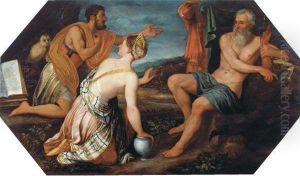Juan De Roelas Paintings
Juan de Roelas was a Spanish painter who played a significant role in the transition from Mannerism to Baroque painting in Spain. Although the exact date of his birth is not known, he is believed to have been born around 1560 to 1570, possibly in Seville or perhaps in Olmedo, as some sources suggest. His early life and training are not well-documented, but it is presumed he may have had Flemish ancestry or connections, which could have influenced his artistic development.
Roelas started his artistic career in Spain and later traveled to Italy, where he was likely exposed to the work of contemporary Italian artists. This experience would have had a considerable impact on his style, which is characterized by a dynamic use of color, light, and composition, features that herald the upcoming Baroque style. After his Italian sojourn, Roelas returned to Spain and eventually settled in Seville around the beginning of the 17th century.
In Seville, Roelas found success and became known for his religious works, which included altarpieces and paintings for various churches and religious institutions. His work was marked by a dramatic use of chiaroscuro and a powerful sense of realism combined with spiritual intensity. One of his most famous works is 'The Vision of Saint Hyacinth,' painted for the Dominican monastery of San Pablo el Real in Seville. This painting is often cited as a precursor to the Baroque style that would be later epitomized by artists such as Diego Velázquez, who was active in Seville during Roelas's later years.
Juan de Roelas's influence extended to his pupils and followers, who helped disseminate his style throughout the region. Despite his contributions to Spanish painting, Roelas did not achieve the lasting fame of some of his contemporaries and successors. He died in Olivares, near Seville, in 1625. His legacy, however, is recognized in the history of Spanish art as a bridge between the Renaissance and Baroque periods, reflecting a moment of stylistic transition that paved the way for the full flowering of the Baroque in Spain.
